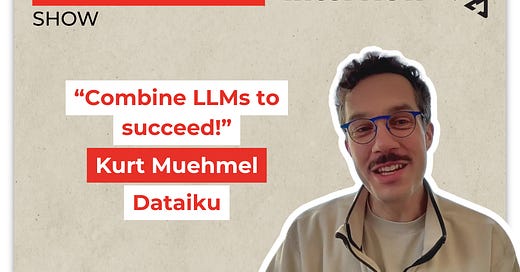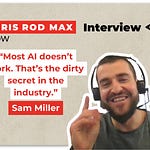In this episode, Chris, Rod, and Max engage with Kurt Muehmel from Dataiku to explore the company’s approach to AI and B2B sales. They discuss Dataiku’s Universal AI Platform, its strategies for building trust with enterprise customers, and the integration of generative AI technologies.
The conversation also touches on current use cases and the challenges organizations face in adopting AI solutions, particularly regarding data quality and access. In this conversation, Kurt Muehmel discusses the challenges and strategies involved in software adoption within large organizations, emphasizing the importance of empathy and understanding user needs.
He shares insights from his journey from environmental consulting to the tech industry, highlighting the role of critical thinking in the age of AI.
Kurt also explores the impact of small teams on startups and the evolving landscape of B2B technology, urging a respectful approach to organizational requirements for successful integration.
Chapters
00:00 Introduction to AI Trends and Dataiku
01:46 Understanding Dataiku’s Universal AI Platform
07:05 Building Trust with Enterprise Customers
14:08 Integrating Generative AI into Dataiku
20:44 Current Use Cases and Adoption Challenges
28:07 Navigating Change Management in Software Adoption
30:52 Lessons from Rolling Out Software in Large Organizations
33:26 Kurt’s Journey: From Philosophy to Tech
39:27 The Role of Critical Thinking in the Age of AI
46:07 The Impact of Tiny Teams on Startups and Innovation
51:23 Building for B2B: Insights and Expectations
Takeaways
Successful enterprise AI adoption requires a universal platform approach that connects diverse data technologies and team capabilities: Kurt explains that large organizations face unique challenges in AI adoption due to their complex data environments, security requirements, and diverse workforce skills. Dataiku’s ‘Universal AI Platform’ addresses these challenges by providing connectivity to various data sources and AI technologies (from traditional ML to modern LLMs), governance frameworks for security and compliance, and multiple interfaces (full code, low code, and no code) to enable different team members to collaborate. This approach recognizes that the most successful companies will be those that can combine different technologies and skill sets within a single governance framework, rather than siloing capabilities across separate tools and teams.
The evolution of enterprise AI is moving from isolated use cases to orchestrated agent systems that require new governance frameworks: The podcast highlights how enterprise AI adoption has evolved from basic analytics to machine learning to today’s generative AI applications. Kurt describes how organizations initially focused on creating enterprise chatbots and RAG systems, but are now moving toward AI agents that can autonomously perform tasks. This shift introduces new challenges around what Kurt calls ‘agent orchestration’ or ‘agent ops’ - the management of multiple AI agents working together as a workforce. This requires sophisticated monitoring, controls, and governance to ensure agents operate appropriately, comply with security requirements, and remain cost-effective. The future belongs to organizations that can successfully manage this transition from single-agent use cases to orchestrated multi-agent systems that deliver differentiated value.
Technology adoption is fundamentally a human challenge that requires empathy rather than technical superiority: One of Kurt’s most surprising lessons from helping large organizations adopt new technology was that ‘some people like really bad software.’ He explains that regardless of how objectively superior a new technology might be, users who have relied on familiar tools for years often resist change. Kurt emphasizes that successful technology adoption requires profound empathy - acknowledging the comfort users have with existing systems while helping them transition to new approaches in ways that minimize disruption. This insight extends beyond enterprise software to broader AI adoption, suggesting that the most successful AI implementations will be those that consider the human elements of change management alongside technical capabilities. As AI continues to transform how we work, this human-centered approach to technology adoption becomes increasingly important.
YouTube Episode
Spotify Podcast
Episode Transcript
Introduction and Welcome
Chris (00:01.09) Welcome to another episode of the Chris Rod Max show where every week we speak about AI news, AI trends, and connect with amazing founders and innovators in the AI space to bring you the latest and greatest in innovation. I’m really excited to be joined by my co-hosts Rod and Max, and our special guest today, Kurt Muehmel. Kurt, we’re delighted to have you on the show!
Kurt Muehmel (00:32.323) It’s my pleasure to be here. Thanks Chris, Rod, and Max for having me.
Chris (00:37.998) Amazing. Today we want to explore your experience with go-to-market strategies and B2B sales. You currently work for Dataiku, and we’d love to understand what your company does exactly. As a later-stage company, you’ve likely gained significant experience with go-to-market approaches and B2B customers.
We also want to learn about your personal journey and career path that led you to where you are today. And of course, we’ll get your perspective on some recent AI trends and developments. Does that sound good?
Kurt Muehmel (01:24.793) That sounds fantastic. I’m honored to think that my perspective might be interesting to your audience. Thank you very much for the opportunity.
Dataiku’s Business Model and Market Position
Chris (01:34.222) Great, so why don’t you start by telling us more about what Dataiku actually does and how you differ from similar players in the market?
Kurt Muehmel (01:46.947) Absolutely. So Dataiku — and regarding pronunciation, there are many schools of thought, so we never correct anyone. At Dataiku, we call ourselves the Universal AI Platform. We offer our customers the ability to control all of their different AI talents, processes, and technologies so they can create all the analytics, models, and agents their company needs.
To explain further, it’s important to understand our target customers. We primarily focus on the Global 2000 companies — the world’s largest 2000 companies. These are big organizations with significant amounts of data but also substantial constraints in terms of security, privacy, and regulations. Our customers span various industries: banking, insurance, manufacturing, retail, and more. Many are companies you interact with daily as a consumer, while others operate more in the B2B space.
These organizations need a way to connect to all their different data sources and the various technologies they use to work with that data — everything from data storage and compute to AI services from their preferred providers. They also need ways for their diverse team members to collaborate on that data, enabling both their most advanced users (data engineers and data scientists) as well as business experts who may not have “data” in their title.
Dataiku provides that platform with connectivity, governance, and multiple interfaces — full code, low code, and no code — so teams can work together to build solutions with their data.
As for how we’re different from other market players — well, there are many players, and Dataiku’s positioning is relatively broad. That’s what we mean by calling ourselves the “universal AI platform.”
Many of Dataiku’s partners like Snowflake, Databricks, and major cloud providers have functionality that overlaps with Dataiku. However, Dataiku doesn’t provide the storage and compute layer — we definitely need them. What we add on top is additional functionality to enable non-expert users. We handle much of the lower-level plumbing so organizations can focus on developing new use cases rather than getting different services to work together.
We really offer customers the opportunity to keep their options open. One challenge some customers face is that starting with a single cloud provider can create a closed ecosystem they’re stuck in. One of Dataiku’s core philosophies is that new technologies will emerge, and organizations will want to leverage these innovations. Dataiku provides that connectivity and optionality so they can adopt new technologies when appropriate.
We’ve seen this evolution during Dataiku’s nearly 13-year history. When we started, the main data paradigm was Hadoop — the big challenge was helping people use Hadoop without writing MapReduce code themselves. This evolved briefly to cloud-based Hadoop, then to object storage and distributed cloud computing. Now we have data lake, data warehouse, and data lakehouse providers, plus technologies like Kubernetes for distributing compute. And of course, we’ll discuss the emergence of AI shortly.
Ultimately, what makes Dataiku different is that optionality, the ability to enable users of all types, and our core philosophy of governance built in from the ground up.
Building Trust with Enterprise Customers
Chris (07:05.01) Thank you for that overview. So essentially, Dataiku is a day-to-day platform that serves as an interface for multiple stakeholders and users, but more importantly, it’s a way to integrate new technologies for a company. And you’re targeting the biggest players in the market. My next question is: how do you build trust with these organizations? Given that many large companies already work with tech giants like Microsoft or Oracle, how do you convince them to choose your solution?
Kurt Muehmel (07:45.945) That’s been a question for Dataiku from the very beginning. I had the pleasure of joining Dataiku early on, initially as a seller. These were literally the first discussions I had my first week — customers asking me those exact questions. Ten years later, that remains the same challenge whenever our sales team approaches a new customer.
The saying has evolved over the years, but people still say “Nobody ever gets fired for buying…” — it used to be IBM, then Oracle, now Microsoft. Those are excellent, safe choices. So what we always do is establish proof in the sales cycle — proof that our technology claims are valid and backed by the product.
Culturally as a company, from a product and marketing perspective, we’re actually very conservative. We focus on talking concretely about what our product does today. We’re not selling a future or a dream — we’re really pragmatic, perhaps sometimes to a fault. But that helps establish credibility.
Other forms of proof come from existing customers. Every software vendor has customer case studies with impressive logos and ROI numbers, so that’s not differentiating. But what we do, when necessary, is introduce prospective customers to existing customers, ideally in the same industry or similar role, so they can hear the story directly from their peers. We can do this in our enterprise sales motion, and thankfully, our existing customers are often motivated to help, which is tremendously valuable. There’s a legitimacy that comes from that peer validation.
A third important source of trust is third-party validation, particularly from analyst firms like Gartner. Dataiku is proud to be a leader in Gartner’s Magic Quadrant for several consecutive years. We invest significant time ensuring analyst firms thoroughly understand Dataiku so their analyses accurately reflect who we are.
Of course, if we go back ten years to when we were just starting, we didn’t have much of that. So what did it take to go from zero to one? I’ll be honest — there was a certain degree of luck. For Dataiku and me specifically, that luck came in finding someone at a large pharmaceutical company in the United States. This person saw part of his role as seeking out promising startups and allocating some budget to test their software, viewing it as a way to make the startup ecosystem more dynamic.
We connected after he discovered some videos Dataiku had published. That was the beginning of an opportunity for him to evaluate our technology with his teams, establish trust, and ultimately spend some budget on Dataiku. That first step was crucial in building credibility with other customers, as we could now say we were trusted by a recognizable company in a highly regulated market.
I think it’s essential for early-stage companies to find those champions. They exist, but there’s an element of luck involved, along with hard work. And obviously, you must respect their trust — trust is hard earned but easily lost. This philosophy extends to how we run our technical support team; we’re maniacal about providing exceptional support. That’s another way to reinforce trust and prevent it from gradually eroding until a supporter no longer advocates for you.
Finding the First Customer
Chris (13:19.758) I always feel like with enterprise business models, it’s a chicken and egg problem. You need references from other companies and experts, but you’ve got to get your foot in the door first. It sounds like you were fortunate or very sophisticated in your approach to that first use case that made things easier. Really interesting.
So focusing on today and AI technologies — agents being a significant development — tell us what you’re doing in this field. How are you integrating AI technology into your connectivity layer?
Integrating AI and LLMs at Dataiku
Kurt Muehmel (14:13.625) If we’re talking about generative AI and particularly large language models, Dataiku actually had our first integration with GPT-3 about a year before ChatGPT was released. This wasn’t yet on most people’s radar, but as with many technologies, there was some demand from customers and curiosity on our side.
We wanted to explore what we could do with these new language models alongside the traditional machine learning models that were the primary focus on our platform. So we created a plugin for natural language text generation connecting to GPT-3, which saw moderate use. But the interest and attention fundamentally changed when ChatGPT arrived.
Our approach then was first and foremost to talk with our customers. Many came to us after their winter holidays because their boards of directors were asking, “What’s our AI strategy?” — the board members had been playing with ChatGPT between Christmas and New Year’s.
Customers asked us to help them understand this technology and its potential. We spent time discussing and exploring possible applications with them. It’s been an evolution since then, but some elements have remained stable.
One key element is broad connectivity, which came together in what we now call LLM Mesh — our connectivity layer to all the different LLMs an organization might want to use. This includes all major providers like OpenAI and Anthropic, the cloud platforms, and self-hosted options for organizations that want to run open-source or open-weights models on their own hardware.
Dataiku supports all these approaches because we see valid use cases for each. We believe the most successful companies will combine different LLMs from different providers for different applications, and having that freedom of choice will be crucial.
So Dataiku’s approach provides controlled connectivity where you can manage permissions and access to different technologies across the organization through LLM Mesh. This includes our guardrails services for cost control, safety, and content moderation — features you’ll need regardless of the use case, so you don’t want to redevelop them for each application.
Beyond the connectivity layer, we provide tools for building with generative AI, including a prompt engineering environment called Prompt Studios. More recently, we’ve focused on agent development capabilities.
Agents represent a new modality for building with generative AI. Initially, the primary format was chatbots — organizations wanted private versions of ChatGPT. Then they wanted document search with RAG capabilities, which Dataiku addressed with our Dataiku Answers product and built-in RAG functionality.
Now we see the emergence of agents, which I believe will be the primary use case for LLMs in enterprises going forward because it’s so flexible and broad. Dataiku provides the ability to create and provide tools to agents, with interfaces for building agents through both visual no-code and coding approaches — because our customers need both options for different users.
Moving forward, the focus is shifting from building individual agents to managing a workforce of agents — entering the field of agent orchestration or “agent ops.” This includes designing how agents interact, creating multi-agent systems, implementing monitoring and controls, and establishing governance to ensure these agent workforces operate appropriately within IT and security requirements while optimizing for budget. One risk with agents is that if they run autonomously, they can quickly become expensive.
These are the considerations enterprises face when building and using agents. It’s relatively easy for anyone to build a single agent with off-the-shelf tools or license an agent from a provider if you have the budget. The real challenge is building agents at scale to create something truly differentiated and managing them effectively as the technology matures.
Evolution of Data Science and AI Use Cases
Rod (20:44.834) You mentioned that Dataiku has been around for a while — you brought up Big Data, which is a term I haven’t heard in quite some time. Reflecting on that, there have been multiple adoption waves: Big Data, Data Science, Deep Learning, and so on. Since Dataiku has a strong foothold in the enterprise market, I’m curious: looking at it today, what are the main use cases if we break it down as a percentage? What are enterprises doing with Dataiku, and how would you allocate percentages to different disciplines?
Kurt Muehmel (21:19.383) That’s an excellent question. What we’re seeing right now is a widening spectrum of customer use cases. Overall, companies use Dataiku for several major categories:
First, there’s modern or advanced analytics — this is extensive data work and automation, building new analytics, combining previously separate data sources, and developing analytics for teams across the organization, often feeding into business intelligence platforms. There’s a lot of analytics engineering happening in Dataiku.
Second, there’s machine learning and MLOps work, where data science teams develop and scale numerous machine learning models. This includes predictive maintenance models for industrial customers, pricing models for insurance companies, and everything in between.
Third, there’s generative AI use. If we look at volume or absolute numbers, you’d probably see a predominance of analytics use. Not because it’s necessarily the most important or valuable, but because that’s much of the work organizations need done today — what people spend most of their time doing.
Then you have a smaller but significant percentage focusing on machine learning and MLOps — extremely valuable work, but there are relatively fewer data scientists than analysts, which tilts the balance.
And now we have this massive uptake in generative AI, which is also changing how the other types of work are performed. For example, Dataiku has built-in AI-powered assistance for analytics and machine learning work. We’ve recently introduced functionality called “Stories” that uses generative AI to automatically create slide decks based on available data.
I think we’ll see the lines between these fields begin to blur. We’ll think less about particular techniques (analytics vs. generative AI) and more about outcomes: building a new metric, dashboard, or agent. And that agent might be building new dashboards — a valid use case for an analytics-oriented agent.
The diversity of use cases somewhat tracks the profile of users, with more analyst-type than data scientist-type personnel. But that doesn’t necessarily reflect where the value comes from.
Ultimately, Dataiku’s overall value is being a single platform for all these capabilities. Our customers appreciate not having to send teams to different tools depending on the task — they have one space to administer all this “data work.”
Data Quality Challenges in Large Organizations
Chris (25:23.022) Kurt, as a follow-up: big companies don’t necessarily struggle with talent to build models, but one significant challenge is data quality, with data being scattered and incomplete. What’s your take on this? How do you help with this issue? What other challenges do large organizations face when adopting a solution like yours?
Kurt Muehmel (25:54.031) You’re absolutely right that the main barrier for machine learning work, and especially now for generative AI work, is data access and quality. That’s why one of Dataiku’s core strengths is our data preparation and engineering capabilities to feed clean data into machine learning models or generative AI systems and agents.
This differentiates Dataiku from more narrowly focused solutions that might excel at ML or agent building but start with the assumption, “bring us a clean dataset.” Much of the work is actually getting to that clean dataset. Having a platform like Dataiku that connects from raw data through preparation and engineering, including a data catalog to identify appropriate datasets for different applications — that addresses a huge part of the challenge.
Regarding adoption, I hope what’s coming across is that Dataiku is positioned differently and more broadly than other platforms. Most organizations have provided different tools to different teams based on their skills — separate solutions for analytics, machine learning, and now exploring options for generative AI.
Dataiku offers a single platform for all these functions, which brings tremendous value. It’s often easy to convince someone in the right position of this value — they see the benefits of a unified environment where there’s crossover between domains, allowing for greater efficiency and easier transition between types of work, plus centralized governance.
But when you reach teams who have been narrowly focused on specific work using particular tools, there’s always a change management challenge. From an individual’s perspective, many are satisfied with their current tools, and even moving to something better still imposes a cost of change. If you rearrange the buttons someone uses for their daily work, that’s disruptive unless they fully understand both the organizational benefits and the personal advantages.
That adoption challenge means we must work closely with teams implementing Dataiku, understanding what users like about their current processes, what frustrates them, and designing a rollout strategy that will make them not just accept but enthusiastically embrace the new platform.
Changing how a large organization handles critical aspects of its business is always an uphill battle, but it’s necessary. I think we’ve gotten increasingly skilled at helping customers achieve the adoption and success they need to become happy Dataiku users.
Lessons from Enterprise Software Implementation
Max (30:24.022) Just to follow up on that, what’s the most interesting lesson you’ve learned from rolling out to some of these largest organizations? Our podcast listeners might be interested in learning about your experiences, given your extensive background. Could you share some of the most interesting or surprising lessons you’ve learned?
Kurt Muehmel (30:52.197) What surprised me most was discovering that some people genuinely like really bad software. There’s software out there that is objectively not great — outdated, lacking valuable capabilities for end users. However, when it’s what you’ve used in your job for possibly 20 years, change becomes extremely difficult.
I think the key is not approaching users with an attitude of superiority — “Here I am, your savior with modern software that will make your life better!” Instead, you need profound empathy: “I understand you’ve been using this software for 20 years and feel comfortable with it. I know your organization has decided to change, which is challenging for you, but let me help you transition as comfortably and seamlessly as possible. And I promise that on the other side, you’ll appreciate the new system.”
You must start from a position of empathy — change is difficult for everyone. Especially when it affects the software you use for six, seven, or eight hours every day. The most important thing is not to assume you have all the right answers. Always enter every interaction looking for what you can learn from that person and how you can help them become both more comfortable and ultimately more successful.
Kurt’s Career Journey
Chris (33:09.344) Empathy is definitely key. Speaking of change, we’re also curious about your personal journey and how you got to where you are today. There were probably many changes given your background. Could you share that story with us?
Kurt Muehmel (33:26.285) Sure. I was born in the US but moved to France shortly after college graduation because I had met the person who’s now my wife during college, and she’s French. I held various jobs initially, including teaching English — something every native English speaker does in a non-English speaking country. After several positions, I wanted to do something closer to my studies.
I had studied two subjects in college: philosophy and environmental sciences. Wanting to return to the environmental field, I found my way into environmental consulting and did that for about five years. But like many consultants, I eventually grew tired of that business model.
I had always been attracted to technology. These were the heyday years when Facebook and Google were exciting companies — from about 2006 to 2014, during the rise of these major tech players. The shine has diminished somewhat now, but I was enthusiastic about that world and wanted to participate in it somehow.
I was particularly drawn to the startup model — a small group of people banding together against the odds to see if they could succeed. Even if they failed, that would be a learning experience.
So I attended a Paris Startup Job Fair organized by an English-language blog about the French startup scene. I distributed my resume to various companies, and one of them was Dataiku.
Why would they hire someone with zero relevant experience? They needed someone who spoke English without a strong French accent because they had begun receiving inquiries from outside France, particularly from the United States. I think there was a mutual willingness to take a chance — me betting on Dataiku and Dataiku betting on me — that has worked out very well, certainly for me and presumably for Dataiku since they’ve kept me all this time.
Over the past decade at Dataiku, I’ve had the opportunity to perform various roles, which has been fantastic. It’s been quite unexpected — when I started, I assumed the company would go out of business within a year because that’s what most startups do, and I would have needed to be prepared for that.
Coming into the space, I didn’t have much ability to assess the product-market fit. I wasn’t a data scientist or from a data background, so I couldn’t judge whether it would be successful. I just really liked the people I was talking to — they seemed smart and hardworking but also fundamentally humane. It was an opportunity to take a leap that I thought would be low-stakes and probably short-term, after which I’d return to get a “real job.”
But indeed, this has become much more of a real job than I ever anticipated.
Cultural and Language Background
Chris (37:46.286) Interesting! And speaking of accents, when preparing for this session, I noticed your German-sounding name combined with your time in France and London. I wondered what kind of accent we’d hear, but you sound very American. You didn’t pick up any British influences.
Kurt Muehmel (38:05.88) My accent does sometimes change depending on my audience — I try to be a bit of a chameleon and match what I’m hearing. But yes, the name is very German. My paternal grandparents were German immigrants to the United States. Since I don’t really speak German, it often causes confusion when I do business in Germany. People see my name, immediately start speaking German to me, and I have to apologize that the language wasn’t genetically transmitted!
Philosophy, AI, and Critical Thinking
Chris (38:42.03) Not yet, not yet! It’s also interesting that you studied philosophy, which seems rare these days. With Rod and Max, we’ve discussed ethical questions around AI safety and disruption. I’m curious about your thoughts on AI and AGI — are people becoming lazier because they don’t have to think as much? What’s your position on critical thinking in the age of AI?
Kurt Muehmel (39:27.139) I decided to study philosophy because it was the hardest course I took in my freshman year. I enrolled in an Intro to Philosophy class because it sounded interesting, and it proved to be my most challenging course that year. I thought, “This is good — this is a worthwhile challenge.” Learning to read complex texts and write with precision and clarity seemed valuable for whatever I might do later. I think that was a good decision by my 18-19-year-old self.
The ability to read, think critically, and write remains essential. For me, writing is how I think — when I need to work through a problem thoroughly, I write it down, often by hand. My brain works best through the physical act of writing, seeing ideas on paper, sometimes sketching concepts, and structuring words into sentences, paragraphs, and essays.
When I use generative AI in my work and personal life, I’m a heavy user but not for those core thinking tasks. I might use it as a sparring partner — “What do you think of this? Are there other approaches?” — but I believe that kernel of thinking requires personal engagement. There are valid concerns that we could lose something in terms of critical thinking if everything is first summarized by an LLM and we’re just writing bullet points for it to expand.
At the same time, it’s wonderful to have tools that help understand complex philosophical concepts. In my current use, when listening to a philosophy podcast, I might ask an AI model to explain ideas and have a back-and-forth: “Is this related to that? Did these thinkers work together? What if I think about it this way?” That can be extremely productive.
So I’m not solely positive about the technology, but I see tremendous benefits as it applies to critical thinking — as long as people use it as augmentation rather than replacement for their thinking.
How this plays out is one of the main challenges facing society: how do we adopt this technology to strengthen not just our businesses but our education and broader social systems? We’ve been discussing enterprise applications, which are certainly important — enterprises provide structure and are where many people work and interact. But especially as we approach AGI, we face fundamental questions about how we interact with each other and what we expect from employment — will we continue working 40-hour weeks, or something different?
These are profound questions that this broadly applicable, general-purpose technology will force us to address as a society. What concerns me is that societal-level discussions today don’t seem to be at their most sophisticated across different governments and populations. We’re entering a volatile period regarding the roles of nation-states and citizens and their interaction with private enterprise — all increasingly mediated and influenced by ever-more-powerful AI technologies.
It’s a fascinating time to be alive! I believe this will be one of the most transformative decades in history, especially because changes are happening so rapidly. Previous industrial and political revolutions often built up and unfolded over decades or centuries, whereas this wave is breaking over us in just a few years. There’s legitimate concern, but also a need for serious thinking from every corner of society — government, private enterprise, and even religion.
AI Startups and the Future of Work
Chris (45:51.822) Honestly, we could do an entire separate philosophy podcast on these fundamental questions. But in the interest of time, I’d like to get your opinion on a recent New York Times article about startups changing Silicon Valley. The piece focuses on the concept of “tiny teams” — companies like Gamma (AI for presentations), Anthropic, or Eleven Labs that achieve remarkable annual revenue with extremely small teams, where previously you might have needed 200-400 people, especially in operations, just to engage with enterprises and convince them to adopt your platform. What’s your take on this trend, and how do you think it will shape the startup and VC landscape, given your experience?
Kurt Muehmel (47:07.237) I saw that article, and honestly, it makes me jealous that this technology wasn’t available when we were a 20-person startup! We discussed the challenges of adopting technology like Dataiku in large enterprises — large organizations move slowly with many pieces to change. Flip that perspective to a 10-40 person company: they have virtually no legacy processes or employees to retrain. Everything can pivot quickly. The opportunity for adopting transformative technology is massive within startups.
These companies offer a glimpse of the future — of new economic models. When I was functioning as both BDR and account executive at Dataiku, I wrote little macros to scrape conference attendee lists, look people up on LinkedIn, and automate messages. Today, I could do all that with an agent — faster, more effectively, and more repeatably.
These AI-first startups are building all their processes with the fundamental question: “How can I automate this? How can I use AI for this?” They assume from the outset that tasks should not be human work, and the question becomes: what must be done by humans? They assume everything should be AI, with human tasks being the exception rather than the other way around.
This previews what future enterprises will look like in many fields. There will be exceptions — human services like nursing, haircuts, dentistry will continue requiring a human touch, literally. But for work primarily done behind computers, any new company should assume everything should be AI-powered, with humans overseeing, managing, and developing those AI capabilities.
This will lead to fundamental changes in company valuations. Like many powerful technologies, this will widen the gap between the successful and less successful, both for companies and individuals. It’s a giant lever allowing you to do more with your capital. Things will move faster, and the path to success may narrow for certain companies as competition increases with more people accessing these tools.
Hopefully, this might widen participation in the startup economy beyond people in a few global hubs or those with advanced computer science degrees — extending to smart, motivated people who might live elsewhere or lack formal training. It will be extremely competitive, but with the potential for extraordinarily high valuations and massive revenue from modest starting points, leading to multiples far exceeding anything we’ve seen before.
Closing Thoughts
Chris (51:01.304) Definitely, and we’ll likely see many more startups entering the market, which is good for competition and innovation. This has been fascinating. As a final question: do you have any parting thoughts for the audience about building for B2B, perhaps connecting to philosophy and AI, before we wrap up?
Kurt Muehmel (51:21.573) For building in B2B, it’s crucial to approach the market with realistic expectations about how large organizations operate. You’ll get frustrated and fail if you assume these organizations can move quickly or take shortcuts with security. View those security questionnaires not as burdens but as critical pathways to success, which means engineering your product to anticipate these requirements. That’s key to moving beyond flashy proof-of-concept demonstrations into becoming mission-critical software. You need to respect these requirements for long-term success in this market.
At the same time, I find B2B work profoundly interesting because, returning to philosophy, it gives me the opportunity to work with diverse companies across many sectors. At Dataiku, positioned across industries, we collaborate with organizations on their most challenging problems. You see where theory meets practice — how private enterprise uses technology to achieve business outcomes in a geopolitical context while expecting human employees to perform specific functions. It’s a convergence of major themes of our time that’s truly fascinating to witness and participate in.
Chris (53:34.606) I’ve learned a lot today. You emphasized the importance of empathy, humility, and taking others seriously. And you shared your passion for understanding business problems and what’s top of mind for companies.
I really enjoyed this session. Thank you so much for joining us. We’ll link your contact information in the show notes. And to our audience, thank you for listening! If you enjoyed today’s episode, please subscribe, like, and sign up for our newsletter. We’ll see you next week.
Your Hosts
Christine Wang: https://www.linkedin.com/in/christinewang0/
Rod Rivera: https://www.linkedin.com/in/rodriveracom/
Maxson J.Y. Tee: https://www.linkedin.com/in/maxsontjy/
Social: X: https://x.com/chrisrodmax
Instagram: https://instagram.com/chrisrodmax
LinkedIn: https://linkedin.com/company/chrisrodmax
Subscribe: https://chrisrodmax.com Tags: #chrisrodmax #ai #technews














Share this post